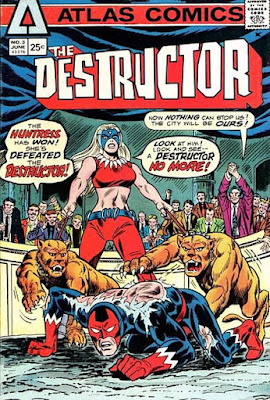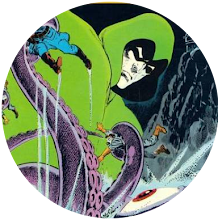If there's one thing I learned from John Buscema and Stan Lee's How To Draw Comics The Marvel Way it's that one should always draw one's characters with their feet wide apart.
I sometimes think that's why I prefer 1970s Marvel to DC. To me, DC Comics always seemed to be a company that stood with its feet too close together. While Marvel was bold, brassy and dynamic, DC seemed somewhat staid, solid and dependable.
Justice League of America #117's a perfect example. Where the Avengers issue I looked at a few days ago was a master-class in imbuing stationary images with movement, mood, intent and urgency, this tale seems to be trundling along the spiritual slow lane. If Marvel were driving a Porsche, DC's Morris Minor was towing Batman's caravan.
What we get is this. There's an alien called The Equalizer who travels the universe, averaging out everyone he meets. Why he does this isn't explained but basically, he's trying to make everyone the same. Now, Hawkman - who's no longer a member of the Justice League - shows up on Mars to average-out himself and the JLA members so he'll get a share of each of their powers and be able to use it to tackle The Equalizer who's already averaged-out the populace of Hawkman's home world Thanagar.
The attempt fails but, fortunately, the rest of the League show up and, after all their attacks are fended off by The Equalizer using an equal and opposite amount of force to whatever they try to throw at him, they hit on the idea of bombarding him with hatred, to make him vanish. I don't understand this. Surely, if they bombard him with hate, he'll simply respond with an equal amount of love? However, the plan works and, instead of giving them all a big hug and a Valentine's card, he goes ka-blooey and everyone's back to normal. At which point the JLA decide to readmit Hawkman to their ranks and we get what seems like a blatant lift from the end of The Avengers #58, the one that closes with the Vision blubbing like a big girl's blouse.
Maybe imitating the Avengers wasn't such a great idea, as it only draws attention to the fact the Justice League of America simply isn't as interesting as The Avengers. Where the Avengers have clearly delineated characters, the JLAers - Green Arrow apart - are pure wood. And, whereas a Marvel villain like Ultron has a bucketful of motivations and complexes - and stands with his feet wide apart - The Equalizer's totally devoid of anything and never even bothers standing up, let alone parting his plates. We're never told why he's doing what he's doing and to be honest, he doesn't even seem that bothered about doing it anyway. To call him passionless would be an understatement. He seems to just be doing things because he doesn't have anything better to do. The tale's pleasantly drawn by Dick Dillin and Frank McLaughlin, but in that generic DC style that a whole bucketful of artists of the time seemed to have, and the space ship designs seem horribly Silver Age to say they were drawn in the 1970s.
Overall it comes across like the reinvention of the comic book as an art form, that Marvel had overseen in the 1960s, had completely bypassed DC who were still churning out the same kind of solid but redundant tales they could just have easily churned out a decade earlier. I suppose it's ironic that the villain in a DC comic should be a creature who makes super-heroes average and identikit when DC's own mindset was doing that already.
Subscribe to:
Post Comments (Atom)









































































6 comments:
It's just as you say. However, it's hardly a surprise, considering how DC failed to fully mine the potential of Kirby's 5 or so years there. They just seemed to have a totally different mindset to Marvel.
A nice, well-considered piece.
I read this in the mid '70s, when it came out, and it has stuck in my mind for thirty-odd years, though I no longer own a copy. (I stumbled across this blog looking for the issue.)
Think of it as a parable, with the Equalizer symbolizing communism/cooperation. That puts the use of hatred to defeat him in another light!
As I remember, it has some terrible poetry. Based on "The Highwayman"?
Hi, Matthew. It does indeed get poetic, at both the very beginning and the very end. The issue's first poetic reference is, as you say, to The Highwayman. I'm not sure from where the poetic section at the end draws its inspiration.
Is it just me or does it look like Yellowjacket behind that curtain on the cover.
You're quite right that the JLA characters, aside from Green Arrow, were pretty bland. You could switch around the word balloons between any two characters and it wouldn't really matter. I do think the JLA had a lot of good art, though.
He looks like a cross between Yellowjacket and Batman.
At least his feet are spread fara apart.
Post a Comment